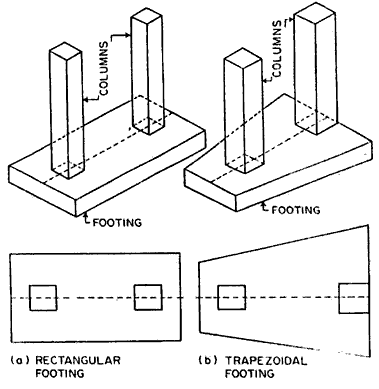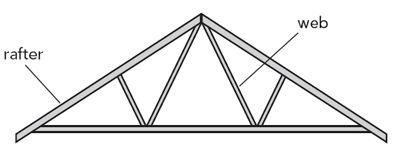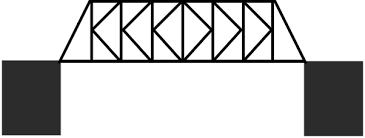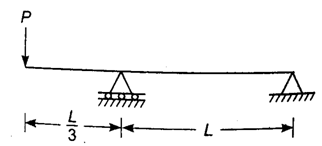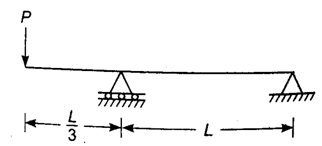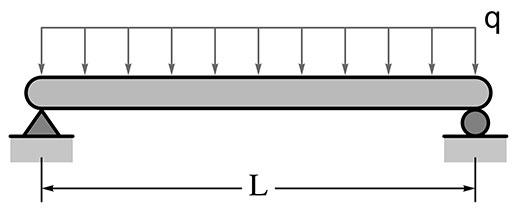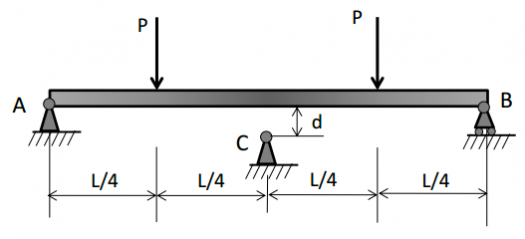Architecture - Sple (Theory Of Structure)

For SPLE Review used only.
- 1.
Reduction factor for flexure without axial load
- A.
0.90
- B.
0.85
- C.
0.75
- D.
0.7
Correct Answer
A. 0.90Explanation
The reduction factor for flexure without axial load is 0.90. This means that when calculating the capacity of a flexural member, such as a beam or column, without considering any axial load, the actual capacity is reduced by 10%. This reduction factor accounts for uncertainties in material properties, construction methods, and other factors that may affect the actual performance of the member. Therefore, the design strength is taken as 90% of the calculated capacity to ensure a safe and reliable design.Rate this question:
-
- 2.
Reduction factor for axial and tension with flexure
- A.
0.90
- B.
0.85
- C.
0.75
- D.
0.70
Correct Answer
A. 0.90Explanation
The reduction factor for axial and tension with flexure is 0.90. This means that when calculating the capacity of a member subjected to both axial and flexural loads, the actual capacity is reduced by 10%. This reduction factor takes into account the interaction between axial and flexural loads and ensures that the member is designed to safely withstand these combined loads.Rate this question:
-
- 3.
Reduction factor for shear and tension
- A.
0.90
- B.
0.85
- C.
0.75
- D.
0.70
Correct Answer
B. 0.85Explanation
The reduction factor for shear and tension is 0.85. This means that the actual strength of a structure or material in shear and tension is reduced by a factor of 0.85. This reduction factor is commonly used in engineering design to account for uncertainties and safety factors. By applying this reduction factor, engineers ensure that the structure or material can safely withstand shear and tension forces without failure.Rate this question:
-
- 4.
Reduction factor for bearing in concrete
- A.
0.70
- B.
0.85
- C.
0.90
- D.
0.75
Correct Answer
A. 0.70Explanation
The reduction factor for bearing in concrete is 0.70. This means that the maximum load that can be applied to a concrete bearing is reduced by 30% due to various factors such as the strength of the concrete, the size and shape of the bearing, and the type of load being applied. A reduction factor of 0.70 indicates that the bearing has a lower capacity and may require additional reinforcement or design considerations to ensure its structural integrity.Rate this question:
-
- 5.
What is the allowable stress for Shear
- A.
0.60Fy
- B.
0.50Fy
- C.
0.40Fy
- D.
0.66Fy
Correct Answer
C. 0.40FyExplanation
The allowable stress for shear is given by 0.40Fy. This means that the maximum stress that a material can withstand in shear is 0.40 times the yield strength (Fy) of the material. This is a safety factor that ensures that the material does not fail under shear loading. By using a lower stress limit, it allows for a margin of safety and helps prevent shear failure in structural components.Rate this question:
-
- 6.
What is the allowable stress for Compression?
- A.
0.60Fy
- B.
0.66Fy
- C.
0.50Fy
- D.
0.40Fy
Correct Answer
A. 0.60FyExplanation
The allowable stress for compression is 0.60Fy. This means that the maximum stress that a material can withstand under compression is 60% of the yield strength (Fy) of the material. This limit is set to ensure that the material does not undergo excessive deformation or failure when subjected to compressive forces.Rate this question:
-
- 7.
What is the allowable stress for Bending?
- A.
0.75Fy
- B.
0.66Fy
- C.
0.40Fy
- D.
0.60Fy
Correct Answer
B. 0.66FyExplanation
The allowable stress for bending is typically expressed as a fraction of the yield strength (Fy) of the material. In this case, the correct answer is 0.66Fy, which means that the allowable stress for bending is 66% of the material's yield strength. This value is commonly used in engineering design to ensure that the material can withstand bending loads without experiencing permanent deformation or failure.Rate this question:
-
- 8.
What is the concrete cover of concrete cast against and permanently exposed to earth
- A.
40mm
- B.
50mm
- C.
60mm
- D.
75mm
Correct Answer
D. 75mmExplanation
The concrete cover of concrete cast against and permanently exposed to earth is 75mm. This is the minimum thickness required to protect the reinforcement from corrosion and provide adequate durability. A thicker concrete cover helps to prevent moisture and other harmful elements from reaching the reinforcement, ensuring the long-term integrity of the structure.Rate this question:
-
- 9.
What is the concrete cover of concrete not exposed to weather or in contact with ground such as bemas and columns?
- A.
40mm
- B.
50mm
- C.
20mm
- D.
60mm
Correct Answer
A. 40mmExplanation
The concrete cover refers to the thickness of concrete that is used to protect the reinforcement bars within a structure. In this case, when the concrete is not exposed to weather or in contact with the ground, such as in beams and columns, a concrete cover of 40mm is sufficient. This thickness provides adequate protection to the reinforcement bars and helps prevent corrosion and damage.Rate this question:
-
- 10.
Is the fastest kilometer wind speed associated with an annual probability of 0.02 measured at a point 10 meters above the ground for an area category C
- A.
Wind speed
- B.
Exposure B
- C.
Exposure A
- D.
Basic wind speed
Correct Answer
D. Basic wind speedExplanation
The basic wind speed refers to the average speed of the wind over a certain period of time. In this case, the question is asking about the fastest kilometer wind speed associated with an annual probability of 0.02, which means that this wind speed is expected to occur once every 50 years on average. Therefore, the basic wind speed represents the speed of the wind that is expected to occur with this frequency.Rate this question:
-
- 11.
Has terrain with buildings, forest or surface irregularities 6 meters or more in height covering at least 20% of the area extending 1.5 kilometers or more from the site.
- A.
Exposure C
- B.
Exposure B
- C.
Exposure D
- D.
Exposure E
Correct Answer
B. Exposure BExplanation
Exposure B is the correct answer because it refers to terrain with buildings, forest, or surface irregularities 6 meters or more in height covering at least 20% of the area extending 1.5 kilometers or more from the site. This aligns with the given criteria mentioned in the question.Rate this question:
-
- 12.
Has terrain which is flat and generally open, extending ½ mile or more from the site in any full quadrant
- A.
Exposure E
- B.
Exposure B
- C.
Exposure C
- D.
Exposure D
Correct Answer
C. Exposure CExplanation
Exposure C is the correct answer because it refers to a terrain that is flat and generally open, extending at least half a mile or more from the site in any full quadrant. This means that there are no significant obstacles or obstructions that could hinder visibility or cause difficulties in accessing the site.Rate this question:
-
- 13.
Represents the most severe exposure areas with basic wind speeds of 130 kph or greater and has a terrain which is flat and unobstructed facing large bodies of water over 1.5 km or more in width relative to any quadrant of the building site
- A.
Exposure D
- B.
Exposure C
- C.
Exposure C
- D.
Exposure E
Correct Answer
A. Exposure DExplanation
Exposure D represents the most severe exposure areas with basic wind speeds of 130 kph or greater and has a terrain which is flat and unobstructed facing large bodies of water over 1.5 km or more in width relative to any quadrant of the building site.Rate this question:
-
- 14.
Are structural elements, the sections of which are composed of built-up lumber, plywood or plywood in combination with lumber, all parts bonded together with adhesives
- A.
Grade
- B.
Glued built up members
- C.
Hardboard
- D.
Fireboard
Correct Answer
B. Glued built up membersExplanation
Glued built-up members are structural elements made by bonding together sections of built-up lumber, plywood, or a combination of plywood and lumber using adhesives. This process creates a strong and durable composite material that can be used for various construction purposes. It is a common method used in the building industry to create beams, columns, and other load-bearing elements.Rate this question:
-
- 15.
The commercial size designation of width and depth, in standard sawn lumber and glued laminated lumber grades; somewhat larger than the standard net size of dressed lumber in accordance with PNS 194 for sawn lumber.
- A.
Nominal size
- B.
Normal size
- C.
Rough size
- D.
Exact size
Correct Answer
A. Nominal sizeExplanation
The correct answer is "Nominal size." In the context of lumber, the nominal size refers to the commercial size designation of width and depth. It is used for both standard sawn lumber and glued laminated lumber grades. The nominal size is typically larger than the standard net size of dressed lumber.Rate this question:
-
- 16.
Is the torsional movement of a diaphragm about a vertical axis.
- A.
Moment
- B.
Cycle
- C.
Spin
- D.
Rotation
Correct Answer
D. RotationExplanation
The term "rotation" refers to the movement of an object around a fixed point or axis. In the context of the question, the torsional movement of a diaphragm about a vertical axis involves the diaphragm rotating around a vertical line. This rotation can be clockwise or counterclockwise, but it is the primary type of movement being described.Rate this question:
-
- 17.
A fibrous felted homogenous panel made from lignocellulosic fibers (usually wood or cane) and having density of less than 490 kg/m3
- A.
Blocked diaphragm
- B.
Fireboard
- C.
Hardboard
- D.
Grade
Correct Answer
B. FireboardExplanation
Fireboard is a correct answer because it is a fibrous felted homogenous panel made from lignocellulosic fibers (usually wood or cane) and has a density of less than 490 kg/m3. Fireboard is commonly used in construction and is designed to have fire-resistant properties, making it suitable for applications where fire protection is required. It is often used as a building material in areas where fire safety is a concern, such as walls, ceilings, and doors.Rate this question:
-
- 18.
Is a portion of larger diaphragm about a vertical axis
- A.
Blocked diaphragm
- B.
Glued members
- C.
Structure members
- D.
Subdiaphragm
Correct Answer
D. SubdiapHragmExplanation
A subdiaphragm is a portion of a larger diaphragm that is blocked or separated about a vertical axis. It is typically made up of glued members or structural members.Rate this question:
-
- 19.
What footing is in the figure below?
- A.
Strap
- B.
Isolated
- C.
Combined
- D.
Wall
Correct Answer
B. IsolatedExplanation
The figure below shows a single footing that is not connected to any other structure or element. It is standing alone and is not combined with any other footings or walls. Therefore, the correct answer is "isolated".Rate this question:
-
- 20.
What type of footing is the figure below?
- A.
Combined
- B.
Wall
- C.
Isloated
- D.
Mat
Correct Answer
A. CombinedExplanation
The figure shown in the question is a combination of different types of footings. It includes elements of both isolated and mat footings. Therefore, the correct answer is "combined."Rate this question:
-
- 21.
The truss below is called?
- A.
Howe
- B.
K
- C.
Warren
- D.
Fink
Correct Answer
D. FinkExplanation
The given truss is called a Fink truss. This type of truss is characterized by its alternating pattern of diagonal and vertical members, which create a series of triangles. The Fink truss is commonly used in roofing and bridge construction due to its ability to efficiently distribute loads and provide structural stability.Rate this question:
-
- 22.
The truss below is called?
- A.
K
- B.
Warren
- C.
Fink
- D.
Howe
Correct Answer
A. KExplanation
The truss below is called a "K" truss.Rate this question:
-
- 23.
The truss below is called?
- A.
K
- B.
Warren
- C.
Howe
- D.
Fink
Correct Answer
C. HoweExplanation
The truss shown in the image is called a Howe truss. The Howe truss is a type of bridge truss that was commonly used in the 19th and early 20th centuries. It is characterized by its diagonal members that slope upwards towards the center of the span, creating a series of alternating triangles. This design provides excellent strength and stability, making it suitable for supporting heavy loads. The Howe truss is named after its inventor, William Howe, an American engineer who patented the design in 1840.Rate this question:
-
- 24.
The gross cross sectional area of a section minus the average area of un-grouted course of cellular spaces
- A.
Net cross sectional area of hollow units
- B.
Gross cross sectional area of hollow units
- C.
Grout
- D.
Masonry unit
Correct Answer
A. Net cross sectional area of hollow unitsExplanation
The net cross sectional area of hollow units refers to the total area of the hollow units after subtracting any openings or voids within them. This measurement is important because it represents the actual usable area of the hollow units for structural purposes. By calculating the net cross sectional area, engineers can determine the load-bearing capacity and strength of the hollow units in a construction project.Rate this question:
-
- 25.
A beam placed over an opening to carry the superimposed above
- A.
Inverted beam
- B.
Lintel beam
- C.
Dropped beam
- D.
Strap beam
Correct Answer
B. Lintel beamExplanation
A lintel beam is a horizontal structural element that is placed over an opening, such as a doorway or window, to support the load from the structure above it. It is designed to carry the weight of the superimposed load, which includes the weight of the wall and any additional loads like roof or floor loads. Unlike other types of beams mentioned, such as an inverted beam, dropped beam, or strap beam, a lintel beam is specifically used to provide support over an opening.Rate this question:
-
- 26.
What type of support is in the right side of the image below?
- A.
Fixed
- B.
Hinge
- C.
Moment
- D.
Roller
Correct Answer
B. HingeExplanation
The support in the right side of the image is a hinge. A hinge support allows rotation but prevents translation in any direction. It is typically used to connect two members together, allowing them to rotate relative to each other. In the given image, the support on the right side appears to be connected to a rotating member, indicating that it is a hinge support.Rate this question:
-
- 27.
What type of support is in the left side of the image below?
- A.
Hinge
- B.
Roller
- C.
Moment
- D.
Fixed
Correct Answer
B. RollerExplanation
In the left side of the image, the type of support depicted is a roller. A roller support allows the object to move horizontally along the surface, while preventing vertical movement. It is typically represented by a cylindrical shape that can rotate freely. This type of support is commonly used in structures where horizontal movement is required, such as bridges or conveyor belts.Rate this question:
-
- 28.
What type of beam is in the figure below?
- A.
Propped
- B.
Overhang
- C.
Cantilever
- D.
Simple
Correct Answer
B. OverhangExplanation
The beam in the figure is an overhang beam because it has a portion that extends beyond its support. An overhang beam is supported at one end and has a portion that is unsupported or extends beyond the support. In the figure, one end of the beam is supported by a wall, while the other end extends outwards without any support, making it an overhang beam.Rate this question:
-
- 29.
What type of loading is in the figure below?
- A.
Concentrated
- B.
Couple
- C.
Uniformly varying
- D.
Uniform
Correct Answer
D. UniformExplanation
The figure in the question does not provide any information about the loading type. Therefore, it is not possible to determine the type of loading from the given figure.Rate this question:
-
- 30.
What type of loading is in the figure below?
- A.
Concentrated load
- B.
Uniform load
- C.
Uniform varying load
- D.
Couple
Correct Answer
A. Concentrated loadExplanation
The figure shows a single point of load application, indicating that the load is concentrated at one specific point. This type of loading is known as a concentrated load, as it is focused on a small area or point rather than being distributed uniformly across a surface or area.Rate this question:
-
Quiz Review Timeline +
Our quizzes are rigorously reviewed, monitored and continuously updated by our expert board to maintain accuracy, relevance, and timeliness.
-
Current Version
-
Mar 22, 2023Quiz Edited by
ProProfs Editorial Team -
Apr 16, 2020Quiz Created by
Concepcionolan
 Back to top
Back to top




